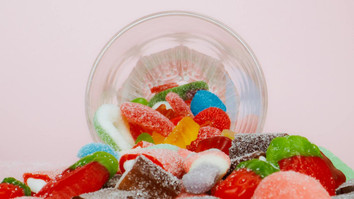Expiration dates aren’t an exact science. The shelf life of edibles is only a manufacturer’s best estimate informed by the typical rate at which ingredients decay when they are maintained in ideal conditions. Considering how environmental factors impact product longevity provides consumers with a greater understanding of the long-term potency and shelf-life of edibles.
How long an edible can last while retaining its intended taste, texture, and cannabinoid structure depends on its interactions with external elements.
Environmental Causes of THC Potency Loss
To answer the question ‘how long do edibles last when opened?’, we’ll have to consult some simple science. We’ll need to discuss how the ingredients in edibles react to their storage conditions over long periods, as well as how cannabinoids like THC molecularly change as a response to external elements.
According to researcher Dr. Natalia Sannikova, environmental factors such as heat, light, and oxygen gradually convert THC into Cannabinol (CBN), a milder cannabinoid with sedative properties. Taking storage precautions helps consumers avoid altering an edible’s intended psychoactive effects.
Moisture
Humidity fosters an ideal environment for microbial growth in edibles. Moisture leads to a breakdown of fats, oxidizing edibles at a faster rate. Baked goods would be most impacted by moisture due to their fat and oil-rich ingredients.
Light
UV light's exposure to food hastens its oxidation and alters the molecular compounds found in edibles, producing the milder psychoactive effects found in CBN. Exposure to light can alter oils and fats, affecting how long an edible can last when opened, including both its freshness and potency.
Heat
Prolonged exposure to heat causes gradual potency erosion in edibles. When exposed to heat, the THC in edibles converts into CBN, causing a milder psychoactive effect. Moderate heat doesn’t majorly disrupt THC molecules, but extreme heat such as leaving edibles in a hot car in the middle of Summer would accelerate the break-down of THC.
Oxygen
Oxygen on its own doesn’t meaningfully impact edible integrity. An edible’s surface area exposure to oxygen is not immediately impactful, but the effects gradually compound as time passes.
Continuous instances of edible exposure to a combination of elements such as light, heat, and oxygen can markedly influence shelf life, according to Dr. Sannikova. Each element, on its own, isn’t significant to maintaining cannabinoid integrity, but combined leads to a rapid decrease in THC potency.
Types of Edibles and Their Shelf Stability

Consumers wondering how long edibles last when opened may find it useful to consider that edibles and their non-THC-infused counterparts spoil at similar rates; for example, the rate at which a brownie edible spoils is the same as a regular brownie’s lifespan.
Gummies
Gummies have minimal moisture levels, delaying cannabinoid potency loss if stored properly. Their ingredients are made up of gelatin, sugar, water, and added flavors. Natural preservatives like sugar make gummies an ideal choice for many consumers.
Lozenges
Lozenges are made up of sugar, corn syrup, water, and flavorings. Their high sugar content is a natural preservative and helps maintain its stability longer than other edibles.
Baked Goods
Baked edibles consisting of milk, eggs, butter, and other ingredients that draw in moisture may require more storage considerations such as refrigeration to avoid microbial growth caused by moisture.
Chocolates
Fat and oils found in chocolates protect from THC potency loss; however, moisture content makes these products more susceptible to spoilage.
Drinks
Because THC and CBD edibles are water-repellent, edible drinks undergo the emulsification process to combine oils with water. Because drinks are high in moisture, they can be more susceptible to spoilage. When made properly, edible drinks provide quick absorption and a stable product.
It’s important to note that THC absorption is affected by dietary habits and a consumer’s physiology will affect the absorption and efficacy of edibles as well. Slowly dose up while figuring out an edible’s true potential.
Signs Edibles Have Gone Bad
Without an exact rate of expiration, consumers can utilize their senses to spot sources of edible spoilage. With knowledge of spoilage indicators, consumers can develop an intuitive sense of how long edibles can last so they may enjoy them before they spoil and at their most potent.
- Look for visual cues such as fuzzy mold caused by the moisture on baked goods. Previously clear hard candies may turn cloudy as a sign of microbial growth.
- Edibles could change in texture, depending on their ingredients, causing them to become excessively stale, crumbling, or oily.
- Drinks may separate liquid layers and develop crystallizations that float on top
- Pungent smells such as sour or vinegary odors indicate the spread of mold.
Similar to all other food, freshness is essential in sustaining the quality of edibles.
Best Storage Practices for Edibles
How long does an edible last after first opening its packaging? The initial moment an edible’s packaging is opened doesn’t cause an immediate decline in potency. Changes in potency happen gradually and are not significant if consumed within a reasonable window of time since purchasing.
Some edible types provide extended longevity and can be stored for prolonged periods. In contrast, some edibles have significantly shorter lifespans due to their ingredient makeup and should be stored or ingested sooner.
Proper storage addresses the issues caused by moisture, light, heat, and oxygen. Consider best consumer storage practices to get ahead of potency loss:
- Keep products away from sunlight exposure near windows.
- Store edibles in a dark environment with opaque packaging.
- Seal edibles inside of an air-tight container to reduce oxidization.
A frequent consumer of edibles may prefer purchasing them in bulk and need to consider how to store them properly for later use. A consumer who plans on purchasing a baked edible may consider if they intend to eat it soon or if they should refrigerate the product to slow down spoilage.
Consumers can make informed decisions based on how long their edibles can last after opening, with peace of mind that they won’t lose potency.

